中考英语听力解题技巧课件
图片预览

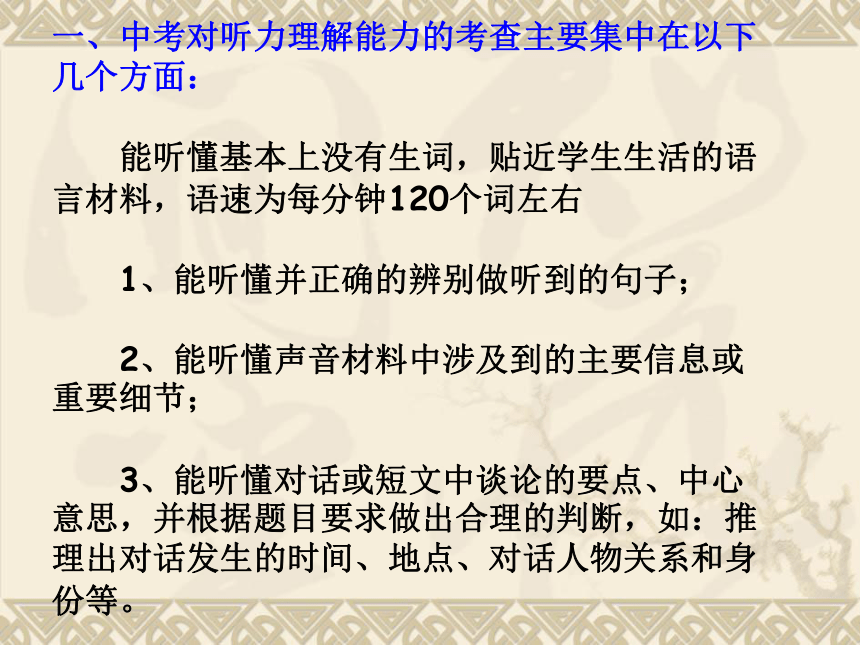

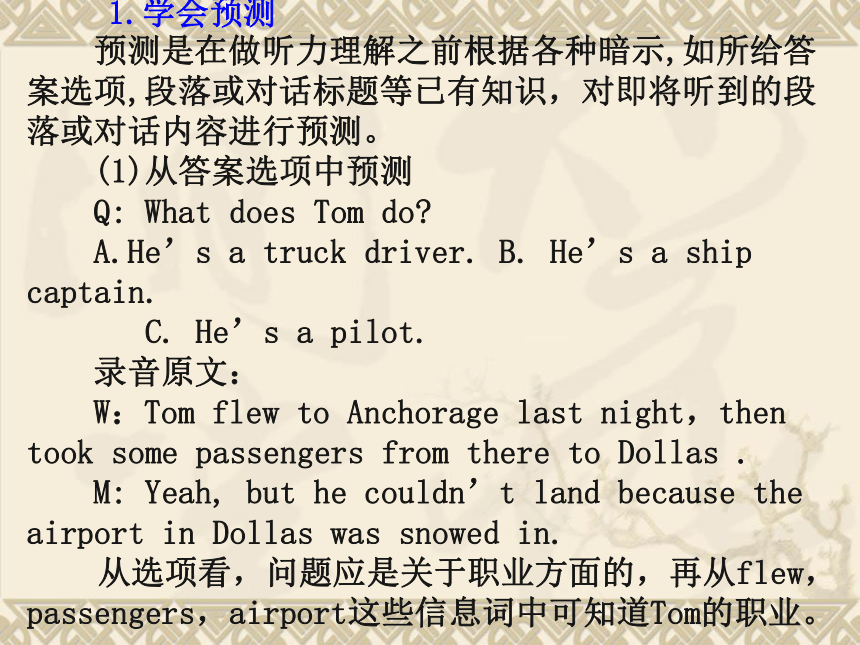
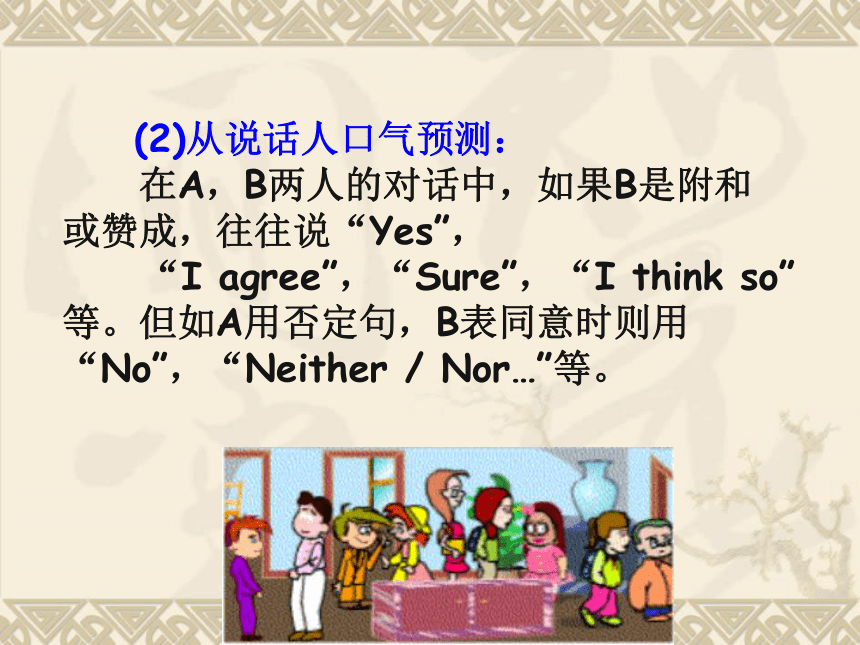
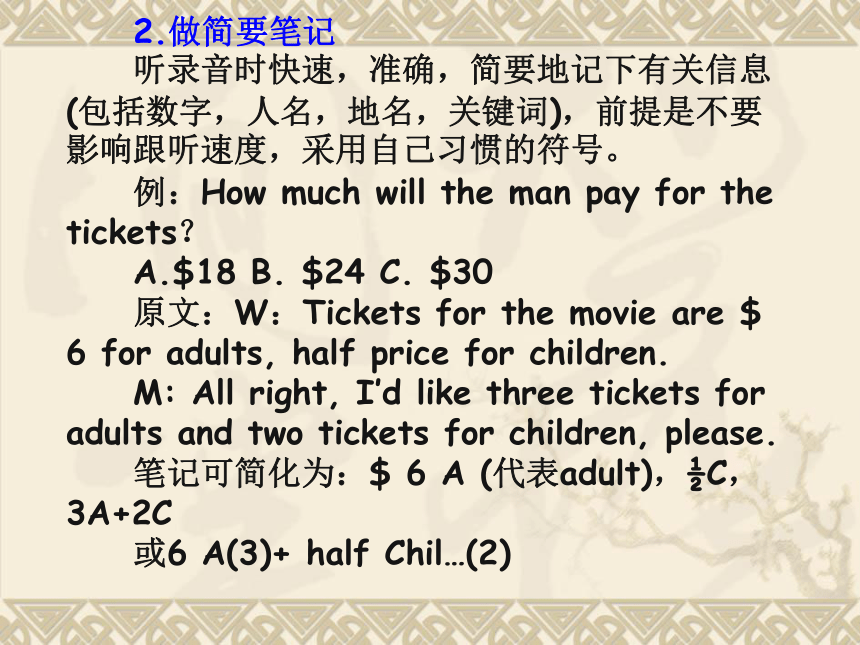

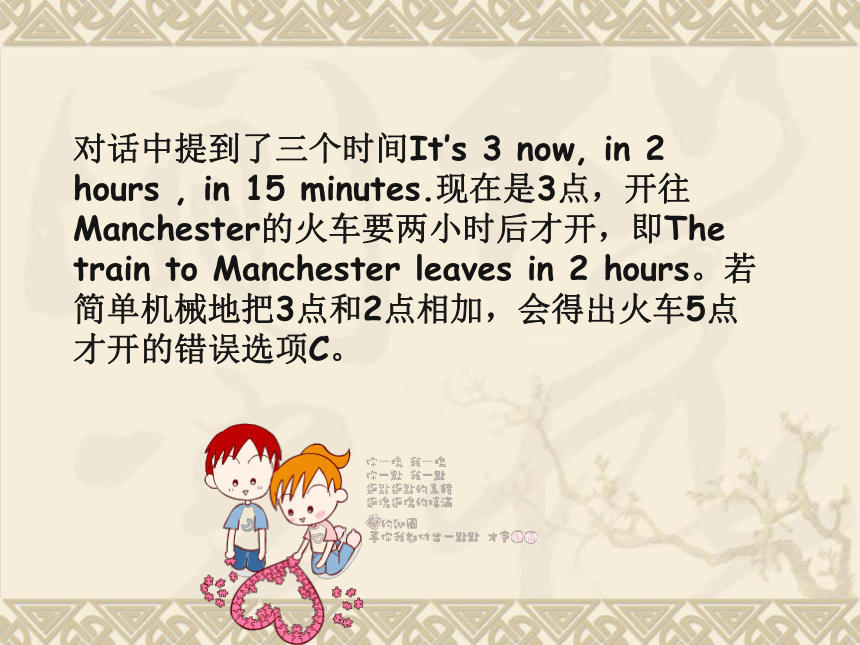
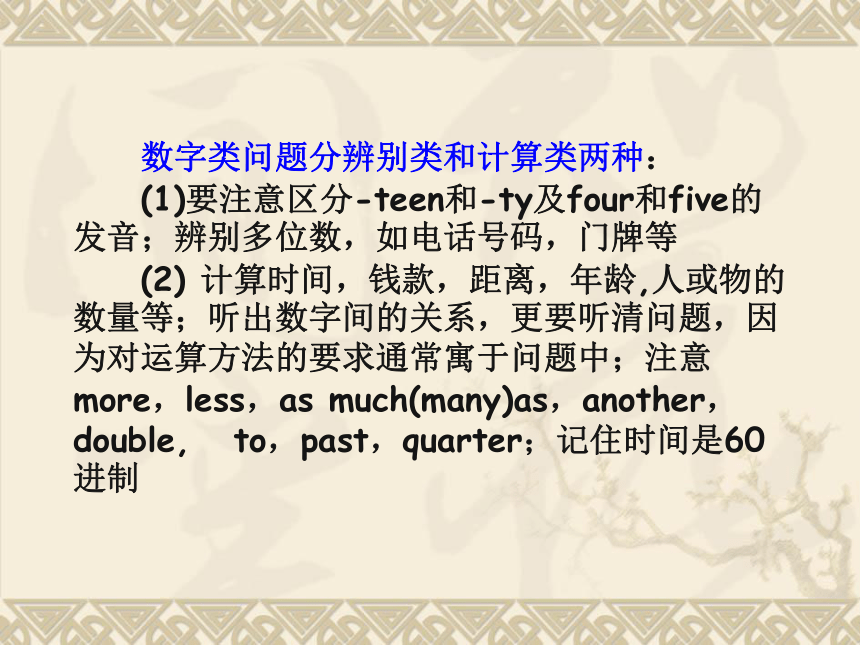
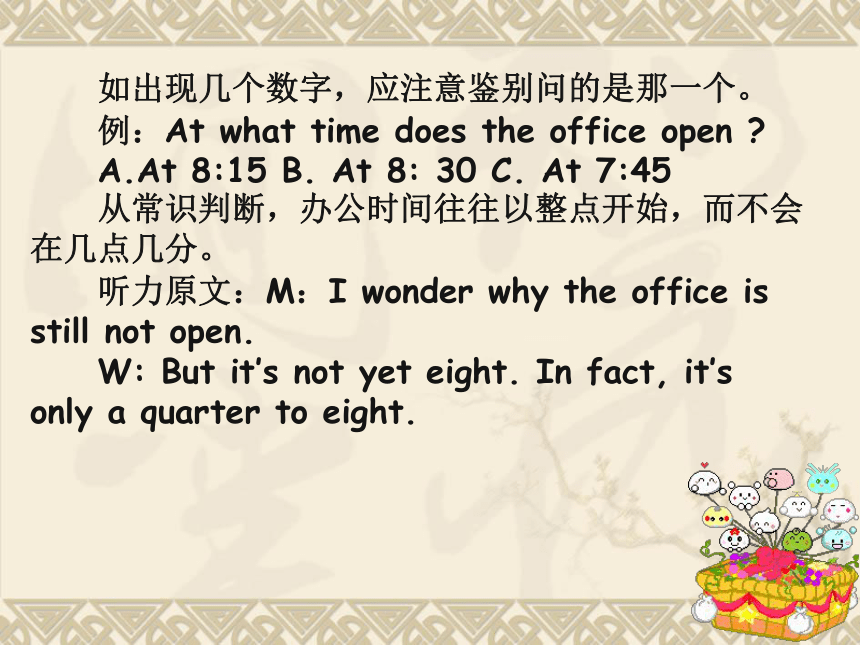

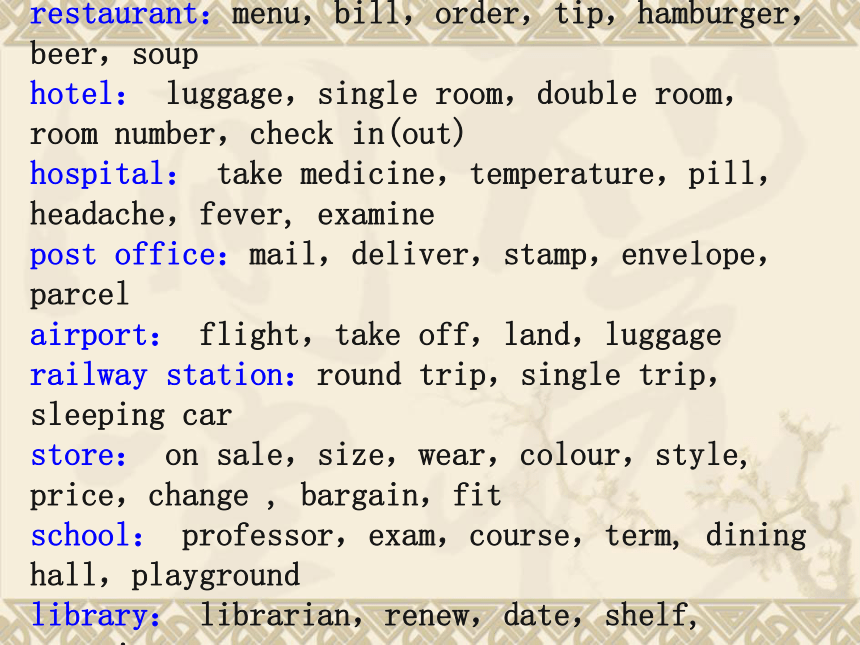
文档简介
课件31张PPT。听力部分的解题技巧 听力部分的解题技巧 一、中考对听力理解能力的考查主要集中在以下几个方面: 能听懂基本上没有生词,贴近学生生活的语言材料,语速为每分钟120个词左右 1、能听懂并正确的辨别做听到的句子; 2、能听懂声音材料中涉及到的主要信息或重要细节; 3、能听懂对话或短文中谈论的要点、中心意思,并根据题目要求做出合理的判断,如:推理出对话发生的时间、地点、对话人物关系和身份等。 二、如何提高听力理解能力和做好听力题? 近两年来中考英语听力的难度在逐渐增加,同学们普遍感觉听力题型不再是轻易拿分的题了.甚至有些同学每次都因听力不好而大量失
分,继而影响英语全卷成绩.在此我们给
同学们总结一些做题技巧,以期对中考
有所帮助. 1.学会预测
预测是在做听力理解之前根据各种暗示,如所给答案选项,段落或对话标题等已有知识,对即将听到的段落或对话内容进行预测。
(1)从答案选项中预测
Q: What does Tom do?
A.He’s a truck driver. B. He’s a ship captain. C. He’s a pilot.
录音原文:
W:Tom flew to Anchorage last night,then took some passengers from there to Dollas .
M: Yeah, but he couldn’t land because the airport in Dollas was snowed in.
从选项看,问题应是关于职业方面的,再从flew,passengers,airport这些信息词中可知道Tom的职业。
(2)从说话人口气预测:
在A,B两人的对话中,如果B是附和或赞成,往往说“Yes”,
“I agree”,“Sure”,“I think so”等。但如A用否定句,B表同意时则用“No”,“Neither / Nor…”等。
2.做简要笔记
听录音时快速,准确,简要地记下有关信息(包括数字,人名,地名,关键词),前提是不要影响跟听速度,采用自己习惯的符号。
例:How much will the man pay for the tickets?
A.$18 B. $24 C. $30
原文:W:Tickets for the movie are $ 6 for adults, half price for children.
M: All right, I’d like three tickets for adults and two tickets for children, please. 笔记可简化为:$ 6 A (代表adult),?C,3A+2C
或6 A(3)+ half Chil…(2)
3.听清数据,简要记下,加以运算。
在获取时间信息时,不要误把会话中提到的时间简单确定为问题的答案。高考听力考查时间时往往要进行简单的时间换算。
At what time does the train to Leeds leave?
A. 3:00 B. 3:15 C. 5:00
录音原文:
W:Excuse me,could you tell me when the next train to Manchester is?
M:Sure. Well,it’s 3 now. The next train to Manchester leaves in 2 hours, but you can take the train to Leeds which leaves in 15 minutes, and then get off at Manchester on the way. 对话中提到了三个时间It’s 3 now, in 2 hours , in 15 minutes.现在是3点,开往Manchester的火车要两小时后才开,即The train to Manchester leaves in 2 hours。若简单机械地把3点和2点相加,会得出火车5点才开的错误选项C。
数字类问题分辨别类和计算类两种:
(1)要注意区分-teen和-ty及four和five的发音;辨别多位数,如电话号码,门牌等
(2) 计算时间,钱款,距离,年龄,人或物的数量等;听出数字间的关系,更要听清问题,因为对运算方法的要求通常寓于问题中;注意more,less,as much(many)as,another,double, to,past,quarter;记住时间是60进制
如出现几个数字,应注意鉴别问的是那一个。
例:At what time does the office open ?
A.At 8:15 B. At 8: 30 C. At 7:45
从常识判断,办公时间往往以整点开始,而不会在几点几分。
听力原文:M:I wonder why the office is still not open.
W: But it’s not yet eight. In fact, it’s only a quarter to eight.
4.抓住关键,对症下药
听力考试常出现以Where提问的问句,考生要通过对话的具体情节和背景判断对话发生的地点。一般来说,特定场景的用语和关键词是基本固定的,考生要对此多了解,熟悉明白。在遇到Where does the conversation take place?/ Where does sb. work?
/ What’s his job?之类的问题时,
就会派上用场。如:
restaurant:menu,bill,order,tip,hamburger,beer,soup
hotel: luggage,single room,double room,room number,check in(out)
hospital: take medicine,temperature,pill,headache,fever, examine
post office:mail,deliver,stamp,envelope,parcel
airport: flight,take off,land,luggage
railway station:round trip,single trip,sleeping car
store: on sale,size,wear,colour,style, price,change , bargain,fit
school: professor,exam,course,term, dining hall,playground
library: librarian,renew,date,shelf, magazine, seat
对于简短对话,要根据问题的类型,从第二个讲话者的答语中来捕捉关键词
如:What’s the man going to do? A. Run to the airport.
B. Wait for another bus. C. Hurry to get the next bus.
根据选项看,对话似乎与bus有关,主要信息捕捉范围是在“Hurry”或“Run”和“Wait”之间。听音范围明显缩小。
录音原文 M:Excuse me,can you tell me when the next bus leave for the airport?
W:It leaves in three minutes. If you run, you might catch it.
关键词“run”和“catch”正好对上答案C的“Hurry”和“get”。
5.果断选题,学会放弃
相信第一感觉,当机立断,决不能反反复复,甚至影响后面的答题
切记不可因某个小题未听懂而患得患失,不可因一题失多题,造成一步跟不上,步步踏空的结果。 注意做题方法。在做听力题时,一定要做到听前先把听力试卷全部看一遍,尤其是听对话和听短文这两种类型,以大概掌握主题内容,缩小听力范围;听第一遍时,不要急于做答,应仔细把全文听完,尽可能弄明白文章在讲什么;听第二遍的过程中,可以适当地做一些记录,如:时间、地点、数字、人物、天气等等,同
时把可能正确的答案做上记号,
检验核对。 总之,听力部分的解题技巧可以总结如下:
1、考生心理素质尤为重要,要有自信心,沉着冷静,静心收听,注意力要集中。 2、 在做题前一定要快速浏览一遍题目和选项,以便听时有所侧重; 3、将没听清楚的词或句子放过去,不要影响了下一道题; 4、在测试过程中要有积极、主动、有意识、有选择的去听; 5、平时加强训练。
(一)对话理解题:让考生听一组对话,在听完对话后,接着由第三者根据对话的内容提出问题,要求考生在领会谈话要旨的基础上,从书面四个备选项中挑选能回答所听到问句的正确答案、或是让考生辨别说话人的职业或者两人之间的关系以及推断谈发生的场合或地点等。
请看以下例题: 三、中考听力题型及解答技巧 听对话和对话后提出的问题,选择正确答案:
( )1、 A. In a restaurant B. In a post office C. In a bank
录音原文:
这个对话是关于寄信的。该题要求根据听到的内容对说话的背景进行推断,在所提供的三个选项中,该对话显然发生在邮局里,正确答案为B。
W: I'd like to send this letter to Britain. Surface mail, please.
M: Ok , that'll be three dollars.
Q:Where are they talking?
( ) 2、 A. some tea B. some coffee C. some juice 录音原文:
该题中女士为男士提供两种饮料,男士又提出了第三种,应该注意不同的选项部分 tea、coffee、juice。这是考查对具体信息理解的典型题目,C为正确答案。
W: what would you like, tea or coffee?
M: Well, how about some juice?
Q: What will the woman give the man? (二)短文理解题:听短文要注意听大意,要善于捕捉整体信息,切莫一个词一个词地听,也不要听一句就翻译一句,更不必因一个词或一个短语没听懂就停步不前,一定要带着短文后的要求和指令去听。听的短文通常是结构紧凑的故事,选用大多是围绕who , when , where , what , how 或why所设的问题。因此,在听的时候应紧紧围绕选项内容作些速记,记下关键词语,理清线索,抓好前后联系,最后才准确作出答案。 如果是听短文填空,听写时要注意前后提示,有的被听写的词可能就出现在短文中,这时可快速做一个符号,以便挤出时间听写其它空白。听写完后,还应检查一下,看用词是否有误、大小写、单复数、时态等有无错误。 本题考察的题型包括:判断所给句子的意思是否正确、选择正确答案、在所缺处填入适当词语、填满表格以及回答所提问题等。本题在听力测试中一般属于中难或难题,考生不仅要听懂一篇完整的材料,掌握其中心意思及重要细节,还要能据此作出分析、推理和判断。尤其需要注意的是,在有的时候,同学们还要从整个对话中了解讲话人的“弦外之音”,特别要注意听清转折和让步,把握说话人的真实含义。
请看以下例题:
(1)听短文,选择正确的答案:
( )1、Mike got up at about ____one cloudy morning. A.7:15?? B.6:45?? C.6:15?? D.7:45 ( )2、He put his books into the bag after he_____. A. left the house?? B. saw his friend C. got to school??? D. washed his face ( )3、He left home_____. A. without breakfast? B. after a quick breakfast C. with his brother?? D. with his sister 1.B 2.D 3.A( )4、On his way, he met his best friend,_______. A. Jim?? B. Tom?? C. Bob?? D. John ( )5、Both of them ______ that morning. A. went to school late??
B. played on way to school C. were late for class??
D. forgot that they had no class 4.C 5.D 录音原文: It was a cloudy morning. Mike woke up and suddenly found it was already 6:45."It's very late,"he thought. He got up quickly, jumped out of the bed, washed his face, put his books into the bag, and ran out of the house without breakfast. On his way, he met his best friend Bob."Bob, we must hurry up, or we'll be late."he said. Then they ran all the way to school. When they got there, they found that they had no class that day. At that moment they remembered it was Saturday. (分析)本题在听短文,选择正确答案的题型中属于较容易题。同学们在听本题前,通过先快速浏览试题所给的5个问题及选项,根据所提供的信息,可以推测出短文所涉及的内容是关于麦克一天早晨如何匆匆忙忙地赶去学校上课的情景。5个问题的内容分别涉及Mike几点起床;什么时间才把书放进书包;他是否吃了早饭上学;在路上他碰到了谁以及那天早晨他究竟出了什么差错。带着这些听前分析的问题开始听录音。第一遍听音时只听不记,把注意力集中在有关问题的内容上,把握全文大意。第二遍听音时边听边看边记,重点把短文中有关内容与相关的题目对上号,分析判断后就能很快选出正确的答案,即:1.B 2.D 3.A 4.C 5.D。 最后对所选定的答案进行验证复查,以避免疏忽造成的错误。 (2)听短文,选择正确答案: ( )1. What did the man have to do in the morning? A. He fed the chickens. B. He cleaned the bath-room. C. He carried water for the family. ( )2.Why did the man go to school on foot? A. No bus ran in the direction. B. The school was near. C. His family was poor. 1.A 2.C ( )3.What did the man do every Sunday? A. He was taken to church three times. B. He stayed at home all day. C. He played in the street. ( )4.What can we learn from what the speaker said? A. He is a retired teacher of history. B. He thinks children were happier in the past. C. He lives on a farm far away from cities. 3.A 4.B 录音原文: Now, you want to know about life in the past, right? I can tell you. When I was a boy, things were different. I had to get up at six every morning. That was not very bad in summer, but in winter it was cold. And we didn't have any hot water in the house. We had to wash in cold water. We didn't have a bath-room. My dad had some chickens. I had to feed them every morning and then I had to walk to school with my little sister. It was two miles to school and two miles back in the evening. And we had to go to bed at seven o'clock every night. We couldn't watch TV because there wasn't any. On Sundays we had to go to church three times-morning, afternoon and evening. And we couldn't play outside on Sundays. But it wasn't too bad. We had some good times. We could go out and our parents didn't have to worry about us. There weren't so many cars on the roads then, so the streets were safe to play in. And there were not many robbers and thieves in those days. We had to work hard and we weren't able to buy all those things in the shops today. Life was hard, but it was simple and people were happier. 本文的篇幅较长,所涉及到的信息教多。但是同学们在做题前浏览一下所提的四个问题和供选项,就会很有效的缩小所听的范围,即重点去听说话人"早上做什么、为何步行上学和每周日做什么"等细节,然后在听完全篇的基础上,概括出第四题的答案就可以了。本题的答案分别是:1.A 2.C 3.A 4.B。 怎么样?做听力的信心提高了吧?See you next time
B. played on way to school C. were late for class??
D. forgot that they had no class 4.C 5.D 录音原文: It was a cloudy morning. Mike woke up and suddenly found it was already 6:45."It's very late,"he thought. He got up quickly, jumped out of the bed, washed his face, put his books into the bag, and ran out of the house without breakfast. On his way, he met his best friend Bob."Bob, we must hurry up, or we'll be late."he said. Then they ran all the way to school. When they got there, they found that they had no class that day. At that moment they remembered it was Saturday. (分析)本题在听短文,选择正确答案的题型中属于较容易题。同学们在听本题前,通过先快速浏览试题所给的5个问题及选项,根据所提供的信息,可以推测出短文所涉及的内容是关于麦克一天早晨如何匆匆忙忙地赶去学校上课的情景。5个问题的内容分别涉及Mike几点起床;什么时间才把书放进书包;他是否吃了早饭上学;在路上他碰到了谁以及那天早晨他究竟出了什么差错。带着这些听前分析的问题开始听录音。第一遍听音时只听不记,把注意力集中在有关问题的内容上,把握全文大意。第二遍听音时边听边看边记,重点把短文中有关内容与相关的题目对上号,分析判断后就能很快选出正确的答案,即:1.B 2.D 3.A 4.C 5.D。 最后对所选定的答案进行验证复查,以避免疏忽造成的错误。 (2)听短文,选择正确答案: ( )1. What did the man have to do in the morning? A. He fed the chickens. B. He cleaned the bath-room. C. He carried water for the family. ( )2.Why did the man go to school on foot? A. No bus ran in the direction. B. The school was near. C. His family was poor. 1.A 2.C ( )3.What did the man do every Sunday? A. He was taken to church three times. B. He stayed at home all day. C. He played in the street. ( )4.What can we learn from what the speaker said? A. He is a retired teacher of history. B. He thinks children were happier in the past. C. He lives on a farm far away from cities. 3.A 4.B 录音原文: Now, you want to know about life in the past, right? I can tell you. When I was a boy, things were different. I had to get up at six every morning. That was not very bad in summer, but in winter it was cold. And we didn't have any hot water in the house. We had to wash in cold water. We didn't have a bath-room. My dad had some chickens. I had to feed them every morning and then I had to walk to school with my little sister. It was two miles to school and two miles back in the evening. And we had to go to bed at seven o'clock every night. We couldn't watch TV because there wasn't any. On Sundays we had to go to church three times-morning, afternoon and evening. And we couldn't play outside on Sundays. But it wasn't too bad. We had some good times. We could go out and our parents didn't have to worry about us. There weren't so many cars on the roads then, so the streets were safe to play in. And there were not many robbers and thieves in those days. We had to work hard and we weren't able to buy all those things in the shops today. Life was hard, but it was simple and people were happier. 本文的篇幅较长,所涉及到的信息教多。但是同学们在做题前浏览一下所提的四个问题和供选项,就会很有效的缩小所听的范围,即重点去听说话人"早上做什么、为何步行上学和每周日做什么"等细节,然后在听完全篇的基础上,概括出第四题的答案就可以了。本题的答案分别是:1.A 2.C 3.A 4.B。 怎么样?做听力的信心提高了吧?See you next time
同课章节目录
- 词法
- 名词
- 动词和动词短语
- 动词语态
- 动词时态
- 助动词和情态动词
- 非谓语动词
- 冠词
- 代词
- 数词和量词
- 形容词副词及其比较等级
- 介词和介词短语
- 连词和感叹词
- 构词法
- 相似、相近词比较
- 句法
- 陈述句
- 一般疑问句和否定疑问句
- 特殊疑问句及选择疑问句
- 反意疑问句
- 存在句(There be句型)
- 宾语从句
- 定语从句
- 状语从句
- 主谓一致问题
- 简单句
- 并列句
- 复合句
- 主谓一致
- 主、表语从句
- 名词性从句
- 直接引语和间接引语
- 虚拟语气
- 感叹句
- 强调句
- 倒装句
- 祈使句
- 句子的成分
- 句子的分类
- 题型专区
- 单项选择部分
- 易错题
- 完形填空
- 阅读理解
- 词汇练习
- 听说训练
- 句型转换
- 补全对话
- 短文改错
- 翻译
- 书面表达
- 任务型阅读
- 语法填空
- 其他资料
